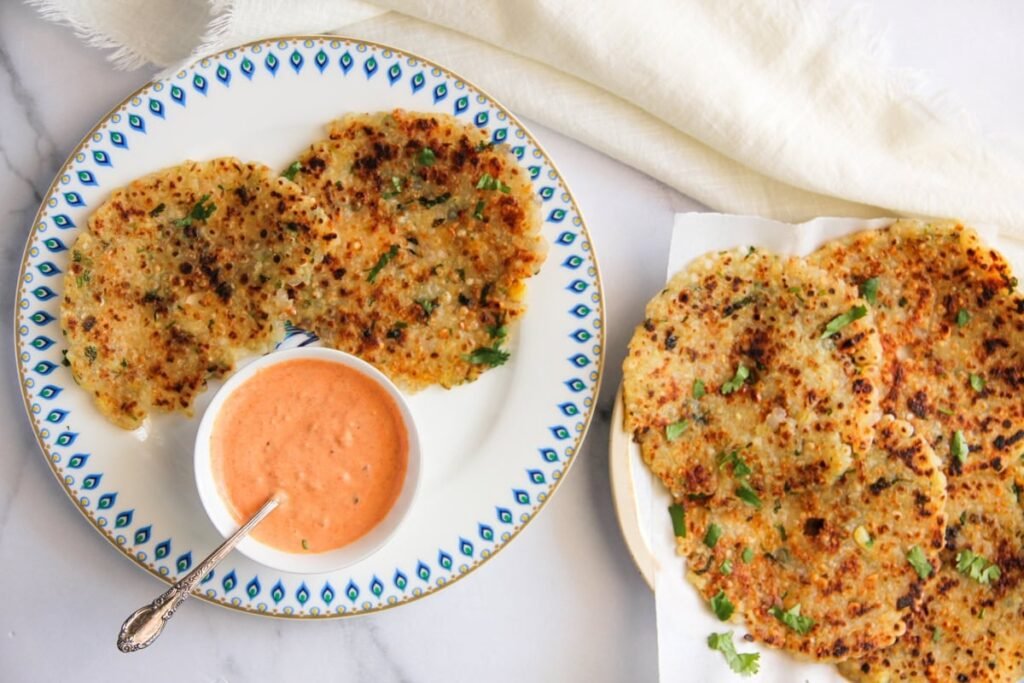Unlock the Flavor: Easy Sabudana Thalipeeth Recipe in 5 Steps!
When you’re in the mood for something truly unique and flavorful, let me introduce you to Sabudana Thalipeeth—a delightful Indian flatbread made primarily from sago pearls. This dish is not only loved for its taste but also for its cultural significance, especially during fasting periods like the auspicious month of Shravan. Eat it during breakfast, lunch, or snack time, and you’ll understand why it has found a special place in Indian kitchens. Its crispy exterior and soft, chewy inside, complemented by hearty spices, create a taste experience that tantalizes your palate. Whether you are observing a fast or simply craving a delicious vegetarian meal, this Sabudana Thalipeeth recipe is bound to impress.
Table of Contents
Budget Information
One of the best aspects of this Sabudana Thalipeeth recipe is its cost-effectiveness. Generally, the total cost of ingredients for approximately four servings hovers around $5 to $7, making it a budget-friendly option that won’t break the bank. This dish incorporates pantry staples like sago, potatoes, and spices, making it not only affordable but also easy to whip up at a moment’s notice, especially if you already have most of the ingredients on hand. Perfect for large families, Sabudana Thalipeeth offers a satisfying meal for everyone.
Why This Recipe Works
This Sabudana Thalipeeth recipe works beautifully because it strikes a perfect balance between simplicity and deliciousness. The straightforward preparation, which generally requires minimal cooking skill, makes it accessible to beginners while still delivering impressive flavors that everyone will love. The recipe is highly flexible, allowing you to tailor the spices and add ingredients like chopped herbs or vegetables to fit your family’s preferences. Furthermore, this dish is gluten-free, dairy-free, and vegan-friendly, making it suitable for various dietary restrictions. It is also high in energy-boosting carbohydrates, making it an ideal meal for those observing a fast or those simply needing a nutritious dish to kickstart their day.
Ingredients + Optional Substitutions
Here’s what you need to make delicious Sabudana Thalipeeth:
- 1 cup sabudana (sago pearls) – Use raw or soaked; the choice is yours. If unavailable, tapioca pearls can be a suitable substitute.
- 2 medium potatoes (boiled and mashed) – Sweet potatoes can be used for a sweeter taste.
- 2-3 green chilies (finely chopped) – Adjust according to your spice tolerance; red chili powder is a more accessible substitute.
- 1/4 cup cilantro (finely chopped) – You can swap cilantro with parsley or omit it if desired.
- 1 teaspoon cumin seeds – Other whole spices like ajwain (carom seeds) work wonderfully as alternatives.
- Salt, to taste – Use sea salt, pink Himalayan salt, or any preferred variety.
- 1 tablespoon lemon juice – Adds brightness; vinegar can also be a good substitute.
- Oil, for frying – Any neutral oil, such as canola or sunflower oil, works well; ghee can be used for added flavor.
Optional Garnishes:
- Finely chopped coriander leaves and mint leaves for freshness.
- Peanut chutney or yogurt for dipping.
Equipment
Before you dive into creating your delicious Sabudana Thalipeeth, gather the following essential kitchen tools:
- Mixing bowl
- Spoon or spatula for mixing
- Tawa or non-stick frying pan
- Rolling pin
- Cooking spray or oil for greasing
- Knife and cutting board
- Ladle for spreading the batter
Step-by-Step Recipe Instructions
Step 1: Preparing Sabudana
Start by rinsing 1 cup of sabudana in running water for about 2 minutes. This helps remove excess starch and prevents clumping. After rinsing, soak the sabudana in enough water to cover it for approximately 4-6 hours. The pearls should absorb the water and become soft and plump. You can test them by squeezing a pearl between your fingers; they should break easily but not be mushy. Once ready, drain any excess water and set the sabudana aside.
Step 2: Mixing the Dough
In a large mixing bowl, combine the soaked sabudana with the boiled and mashed potatoes. Make sure the potatoes have cooled down to room temperature to avoid cooking the sabudana further. Add the finely chopped green chilies, cilantro, cumin seeds, salt, and lemon juice to the mixture. Use your hands to mix everything together thoroughly. The mixture should come together into a somewhat sticky, moldable dough. If it feels too dry, sprinkle a little water; if it’s too wet, a spoonful of extra sabudana can help. The key here is to find the right consistency—one that holds together but isn’t overly sticky.
Step 3: Shaping the Thalipeeth
Once your dough is ready, it’s time to shape your Thalipeeth. Grease your hands lightly with oil to prevent sticking, and take a small portion of the dough. Roll it into a ball and then flatten it gently into a disc shape about ¼ inch thick. If you want a traditional look, make a small indentation in the center with your thumb. You can use a rolling pin, but pressing out with your palms also works well. Repeat this process until all the dough has been shaped. Cover the formed discs with a kitchen towel to keep them moist while you prepare to cook.
Step 4: Cooking the Thalipeeth
Heat a tawa or non-stick frying pan over medium heat and add a tablespoon of oil. Once the oil is hot but not smoking, gently place one disc of the Sabudana Thalipeeth onto the pan. Cook for about 2-3 minutes until you see golden brown spots starting to appear on the bottom. Using a spatula, flip it over and drizzle a little more oil around the edges. Cook for another 2-3 minutes. You want each side to be crisp and golden while the inside remains soft. Remove the cooked Thalipeeth and keep it warm in a covered container. Repeat the same process for the remaining discs. If they start to stick, don’t hesitate to adjust the heat or add more oil.
Step 5: Serving
Once all your Sabudana Thalipeeth are cooked and staying warm, it’s time to serve. Plate them hot, garnished with fresh cilantro and mint leaves if desired. Accompany with a side of peanut chutney or yogurt for a cooling contrast. Enjoy with a squeeze of fresh lemon juice for that extra zing, and pair with a refreshing beverage like chaas (buttermilk) or coconut water. Feast and savor each bite of your beautifully made Sabudana Thalipeeth!
Nutritional Facts
Here’s a breakdown of approximate nutrition per serving (1 Thalipeeth):
- Calories: 160
- Protein: 3g
- Carbohydrates: 30g
- Fat: 5g
- Fiber: 2g
- Sugar: 1g
- Sodium: 300mg
Dietary Tags: Gluten-free, Vegan, Vegetarian
Storage and Reheating Tips
To store your leftover Sabudana Thalipeeth:
- Refrigeration: Place in an airtight container; it can stay fresh for up to 3 days.
- Freezer Safety: Yes, it freezes well! Wrap each Thalipeeth in parchment paper and place them in a freezer-safe bag. They can last up to a month.
Reheating Methods
Reheat your Thalipeeth in the following ways to maintain flavor and texture:
- Microwave: Place on a plate and cover with a damp paper towel. Heat for 30 seconds, then check and continue in 10-second intervals as needed.
- Oven: Preheat to 350°F (175°C), and place in the oven for 10 minutes to heat evenly.
- Stovetop: Place in a hot pan with a drizzle of oil and cook for 2-3 minutes on each side until heated through.
- Air Fryer: Preheat to 350°F (175°C) and air fry for about 5 minutes until crispy.
Serving Suggestions
The best way to enjoy your Sabudana Thalipeeth is hot off the skillet. You can serve it simply or go all out with a presentation. Consider these serving suggestions:
- Serve with a side of tangy peanut chutney or mango chutney for dipping.
- Garnish with finely chopped herbs like cilantro or mint to boost freshness.
- Pair with a cooling cucumber raita to balance the flavors.
- For a more elaborate meal, serve it with a side of spicy potato curry or a light salad.
Don’t hesitate to explore regional variations as well; in some places, it’s served alongside fried green chilies or a spicy pickle for that additional kick.
Reader Tips or Helpful Notes
To assist you further in perfecting this Sabudana Thalipeeth recipe, here are 10 reader-inspired tips:
- Soaking Time: Ensure sabudana is soaked for at least 5 hours for a perfect texture.
- Avoid Dough Stickiness: Lightly oil your hands when shaping, which helps in handling the dough easily.
- Test Cooking: Cook one Thalipeeth first as a test. This lets you adjust spice levels and cooking time.
- Batch Cooking: Make double batches and freeze them for quick meals later on.
- Spice It Up: If you’re adventurous, add spices like garam masala for extra flair.
- Air Frying Option: For a lower-fat option, try air frying at 350°F for 12-15 minutes.
- Leftover Enhancements: Use leftover Thalipeeth to make a quick sandwich.
- Sizzling Sound: Listen for the sizzle when cooking; it’s a good indicator of readiness.
- Storage Containers: Use glass or BPA-free plastic containers for the best preservation.
- Customize Flavors: Feel free to add grated carrots or finely diced bell peppers for a veggie boost!
Recipe FAQs
1. Can I make this ahead of time?
Absolutely! You can prepare the dough in advance and store it in the refrigerator for a day. Shape and cook when ready to serve.
2. Can I freeze it?
Yes, Sabudana Thalipeeth freezes well! Wrap in parchment paper and use a freezer-safe bag.
3. How can I make it vegan/gluten-free?
The recipe is inherently vegan and gluten-free, perfect for various dietary needs!
4. Can I double the recipe?
Of course! Simply double the ingredient quantities and follow the same preparation steps.
5. Is it spicy/kid-friendly?
You can adjust the spice level by modifying or omitting the green chilies, making it mild and kid-friendly.
6. What are the best storage containers?
Opt for airtight containers—glass or BPA-free plastic with lids work best for both refrigeration and freezing.
7. How long can I leave it out before refrigerating?
It’s best to refrigerate within two hours to maintain freshness and prevent spoilage.
8. Can I use an air fryer/Instant Pot instead?
Yes! You can air fry the Thalipeeth for a healthier alternative. Instant Pot isn’t ideal for frying but can be utilized for steaming if you wish.
9. What are the most common mistakes to avoid?
Ensure your sabudana is thoroughly soaked, and don’t overcrowd the pan while cooking, as it can lower the temperature and affect texture.
10. How do I scale this for a party or meal prep?
Simply multiply the ingredients based on how many guests you plan to serve, and consider preparing different variations to please varied palates.
Conclusion
In summary, I invite you to try this memorable Sabudana Thalipeeth recipe that’s sure to impress family and friends alike. It’s a beautiful representation of Indian cuisine that can be enjoyed any day of the week. If you make this recipe, I’d love to hear your feedback! Please leave a review, post your photos on social media, and feel free to ask any questions. Happy cooking!


